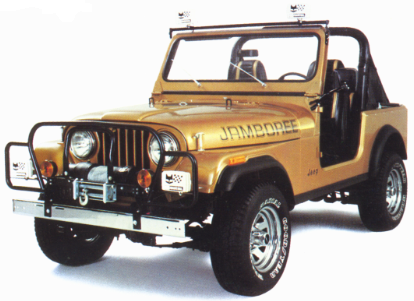
The Rarest CJ-7 Ever Built &
One of the Rarest Jeeps of All Time

 |
1982 Jeep CJ-7 Jamboree The Rarest CJ-7 Ever Built & One of the Rarest Jeeps of All Time  |
| Main | Jambo Registry(TM) | Production | The Jambo | History |
| Parts | Documents | FAQs | Fun | About |
| For Sale: Parts | For Sale: Jambos | Links | Restoration | Silver Registry(TM) |
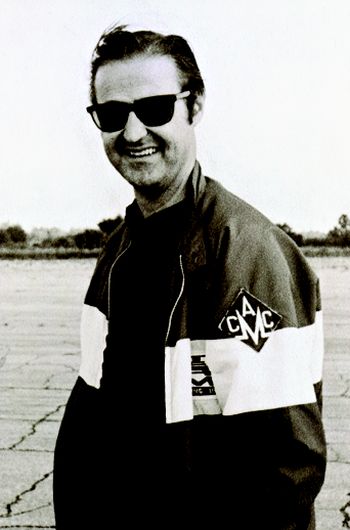 Jim Alexander (1929-2006) |
The Jambo was designed by James "Jim" W. Alexander (1929-2006). Thank you, Jim! You can see Jim's signature at the bottom of the Product Direction Letters (PDLs) shown below. As shown in the PDL below and also available here, the Jambo was born on November 20, 1981. Thank you to Jim Allen for providing this letter! During this meeting, Jeep decided to offer a CJ-7 Special Promotional Package called the "Jamboree" to commemorate the 30th anniversary of the Jeepers Jamboree, which began in 1953. As this PDL details, the basis for the Jambo was the CJ-7 Soft Top, to which several unique components would be added. The Jambo was to be available beginning April 1, 1982. The PDL clearly specifies that all the Jambos would be painted Topaz Gold Metallic and include Laredo-style seats with gold inserts, instead of the Laredo-silver, to match the gold paint. In April 1982, Jeep allowed Jambos to be produced in Olympic White (9B) as well. We believe only 70 were produced, making the "elusive White Jambo" one of the rarest Jeeps ever! |
| This single color and commemorative dash plaque matches the approach taken for the 1979 CJ-5 Silver Anniversary, just three years earlier, with the exception that the Jambo was to be given a serial production number and not just a special dash emblem. The Silver's were painted Quicksilver Metallic (8C), which was not used for any other CJs. So, both the Jambo and the Silver were given a unique paint color that was never used on any other CJ. This is important because it helps to verify authanticity. The package would also include Jamboree decals, a special Jamboree spare tire cover, and a commemorative plaque mounted on the instrument panel (I.P.). Importantly, the Jambos were to be batch built and serialized via the dash plaque, from number 1 to 2500. As we now know, Jeep would only produce about 630 Jambos, making it the rarest CJ-7 and one of the rarest Jeeps of all time. It is also clear that the Jambos were not exactly numbered serially. You can read about that here. |
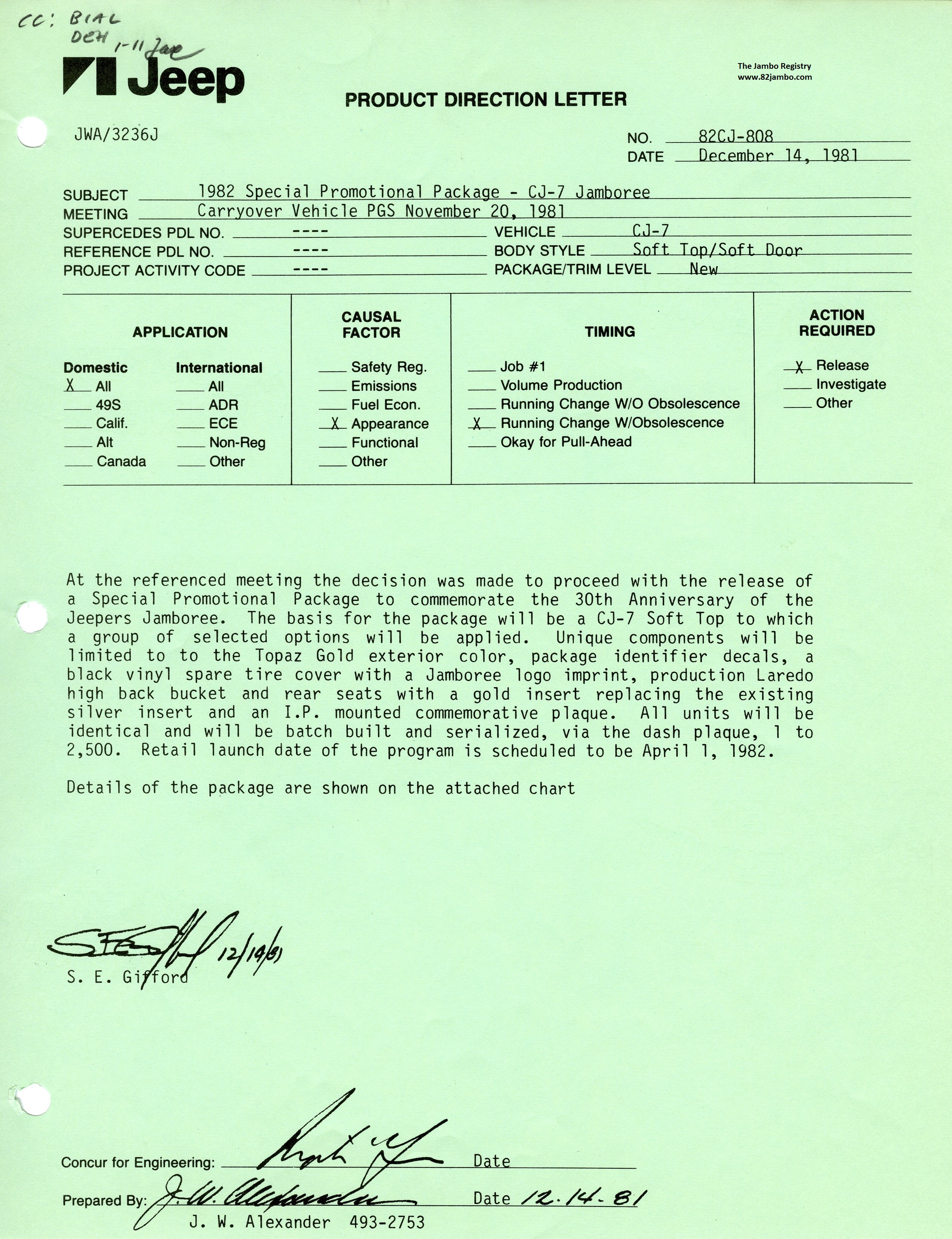 |
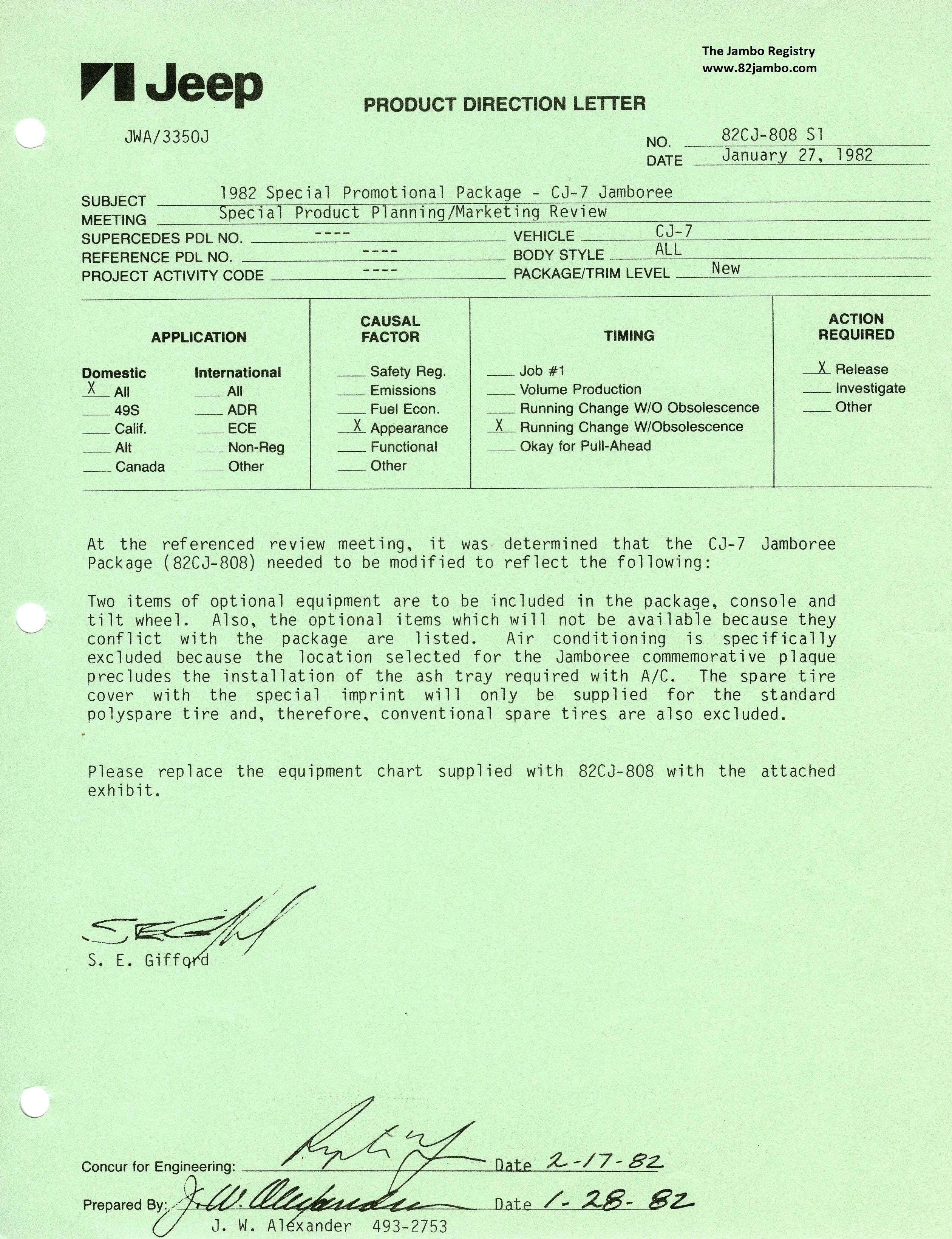 |
On January 27, 1982, Jeep modified the definition of the Jambo as detailed in the PDL to the left or available here Thank you to Jim Allen for providing this! The changes added a black center console and tilt steering. Both of these changes made the Jambo conform to the Laredo specs. Jeep also decided to eliminate the option of air conditioning (AC). They did so, because the CJ AC was under the dash. This required relocating the ash tray to the instrument panel. When Jeep did this on other CJs, the ash tray went right where the Jambo commemorative plaque went. Therefore, Jeep eliminated AC as an option for the Jambo. You can read more about this here. You would rather have an AC than an ash tray? Well, maybe you can drive your sister's Suzuki Samurai. :-) As we discuss below, Jeep later decided to allow AC. However, we suspect this change applied to Jambos with badge numbers between #0001-#0030 and those above #0450. Jeep also eliminated a full-size spare tire because the special Jambo tire cover would only fit the small polyspare. |
| With these changes, the Jambo was defined as
detailed in the chart below and available
here. Thank you to
Jim Allen
for providing this! As you can see, on the exterior, all
Jambos were to come standard with
Topaz Gold Metallic paint, Jamboree hood lettering, chrome wheels,
chrome bumpers/bumperettes, black soft top,
black rocker trim,
and special Jamboree spare tire cover. |
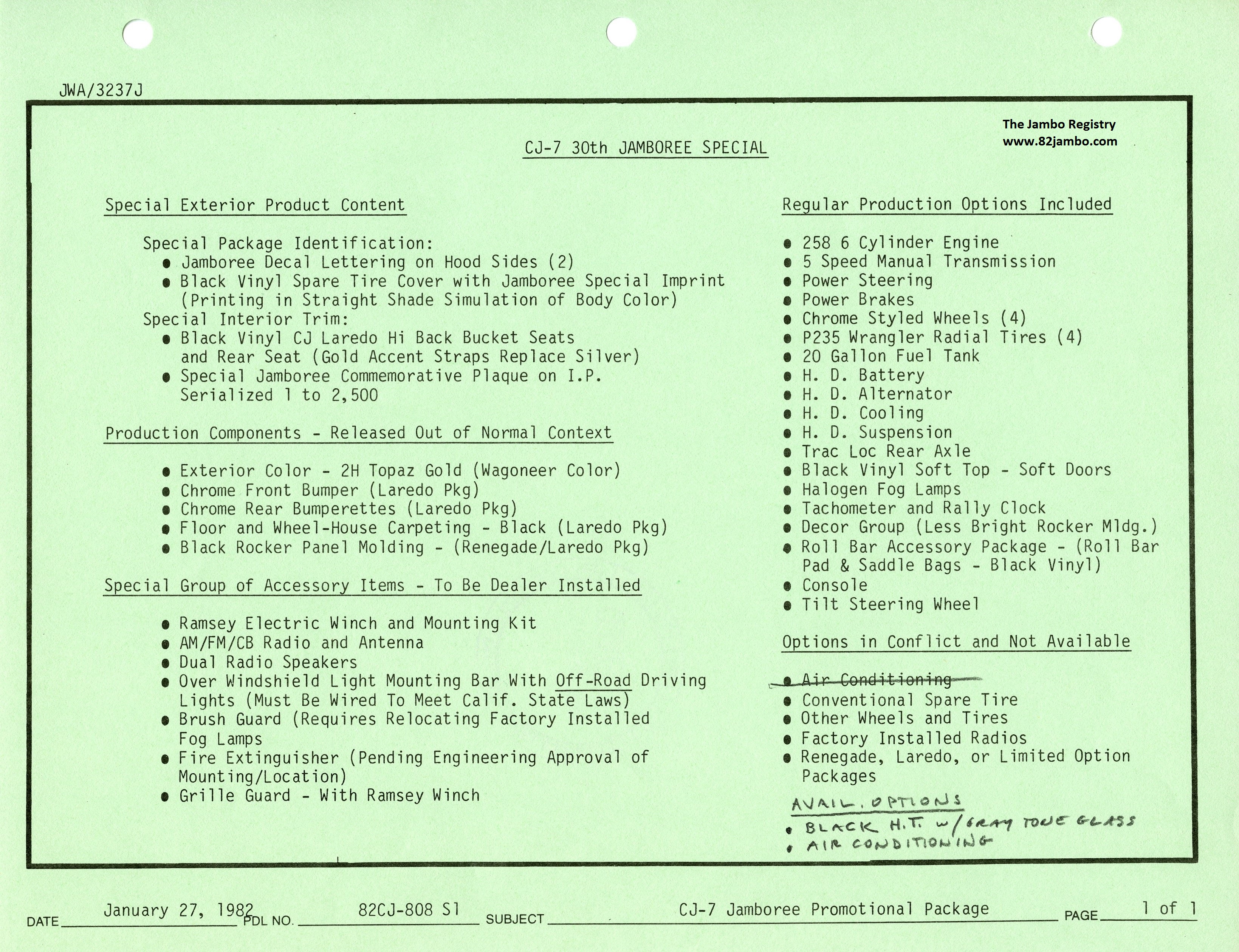 |
On the interior, Jambos had special black bucket seats with gold inserts
(front and rear), center console, black floor and wheelhouse carpeting,
black padded roll bar, saddle bags, and special plaque denoting the
production number mounted on the instrument panel.
Jambos also came standard with the 258 CID 6-cylinder engine (a $150 upgrade
from the 4-cyl), 5-speed manual transmission ($199 upgrade from 4-speed), power steering
($229 upgrade), power disc
brakes ($99 upgrade), 20-gal fuel tank ($49 upgrade from 15-gal), tachometer
& rally clock ($96), Marchal fog lamps ($90),
tilt steering ($99), heavy-duty battery ($0), heavy-duty alternator ($59), heavy-duty
cooling ($49), heavy-duty suspension ($103), Trac-Lok rear differential
($219), and P235/75R15 Wrangler Radials ($722).
Here is the window
sticker for #0555 that shows the prices of these upgrades.
The following options were not available from the
factory: AC, conventional spare tire, non-chrome wheels, and factory
installed radios.
Jeep made about 22 Jambos with the Chyrsler 999 automatic transmission. This was a $409 upgrade.
At some point, Jeep appears to have clarified that a hard top was an available option ($445 upgrade). This is handwritten in the chart above. We don't know when this handwritten change was made. The hard top was to be black with gray-tone glass, like the Laredo. Many Jambos have hard doors. These could have been accompanied by a hard top or a soft top (an iron sides setup). Here is a picture of Topaz Gold Metallic CJ-7 from the 1983 accessories catalog. This is clearly based on a Jamboree without hood lettering and includes a hard top.
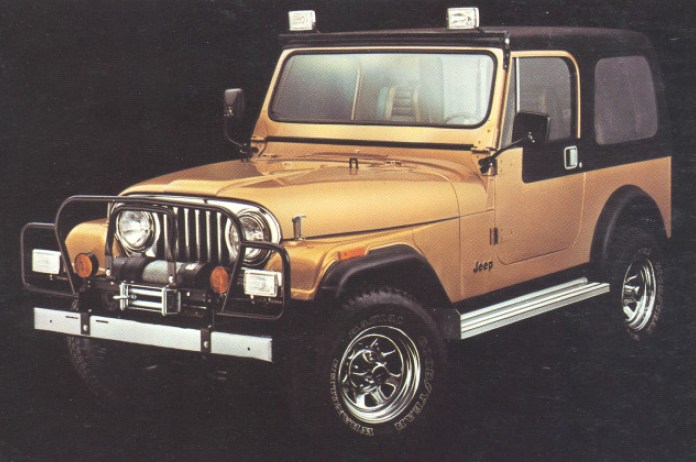
It also appears that AC was ultimately made available, since this handwritten change was made.
The Jambo Registry suspects that this change
was not made until after the initial batch of about 425 Jambos was
produced (after #0450). Thus, Jambos through about #0450 may have all conformed to the
standard above and were painted Topaz Gold Metallic, had manual
transmissions, and did not include AC. However, we do know of at least
one Jambo under #0450 (#0176) that came with
a hard top.
This chart also specifies that the Jambos were to have Black Rocker Panel Molding, as with the Renegade and Laredo. The 1982 Jeep sales brochure does not specify the color or Renegade molding. However, it does state that the Laredo's had black rocker molding in 1982. Every CJ pictured in this brochure, even the Renegade and the Scrambler, has black rocker molding.
The Decor Group included rocker panel molding, sports steering wheel (not leather wrapped), front frame cover, and instrument panel overlay.
The table above does not list the Convenience Group, which was standard on the Laredo. The Convenience Group included tachometer and rally clock, hood insulation, heavy-duty shocks, and spare wheel lock. Since the tach, clock, and shocks (H.D. suspension) are included in the chart above, we do not believe Jambos came with hood insulation or a spare wheel lock.
The internal AMC Product Direction Letters, discussed above, are dated December 14, 1981, and January 27, 1982. As shown in the letter below, dealers were notified about the "JAMBOREE" package on January 29, 1982.
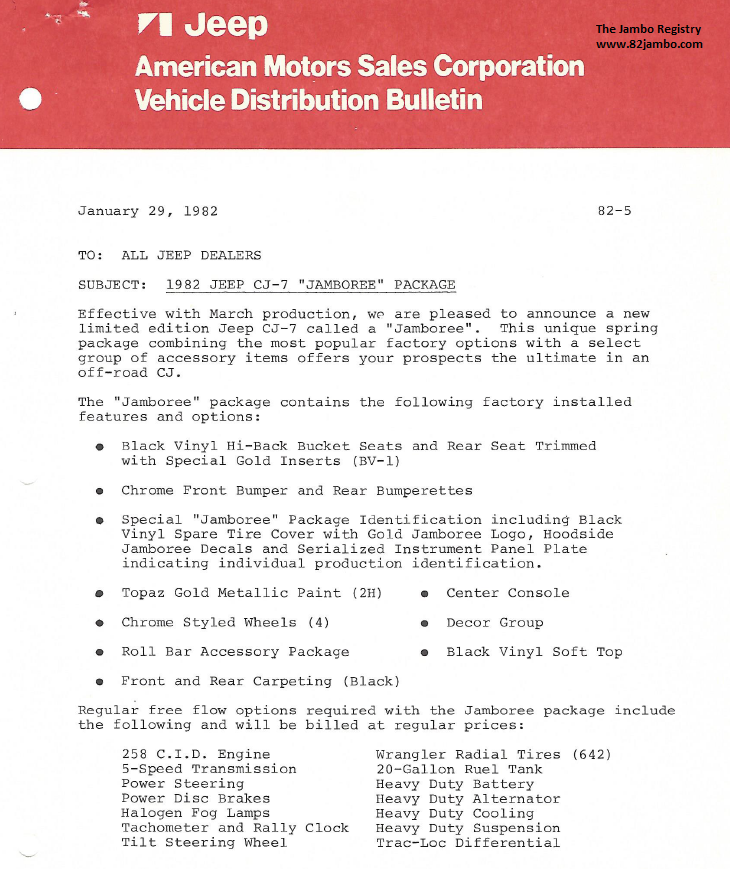 |
Page One: This letter states that the Jamboree
would be produced in March 1982. This is what Jeep referred to as the
1982 1/2 model year, which is when many mid-model-year changes were made
(e.g., Select-Trac was added in March 1982--not for Jambos). Notice that this letter conforms to the specifications laid out in the PDLs presented above. Jambos were to be painted Topaz Gold Metallic. In addition, the Jambo includes many options. In fact, it was the most highly optioned CJ ever produced. Click here for more detail. |
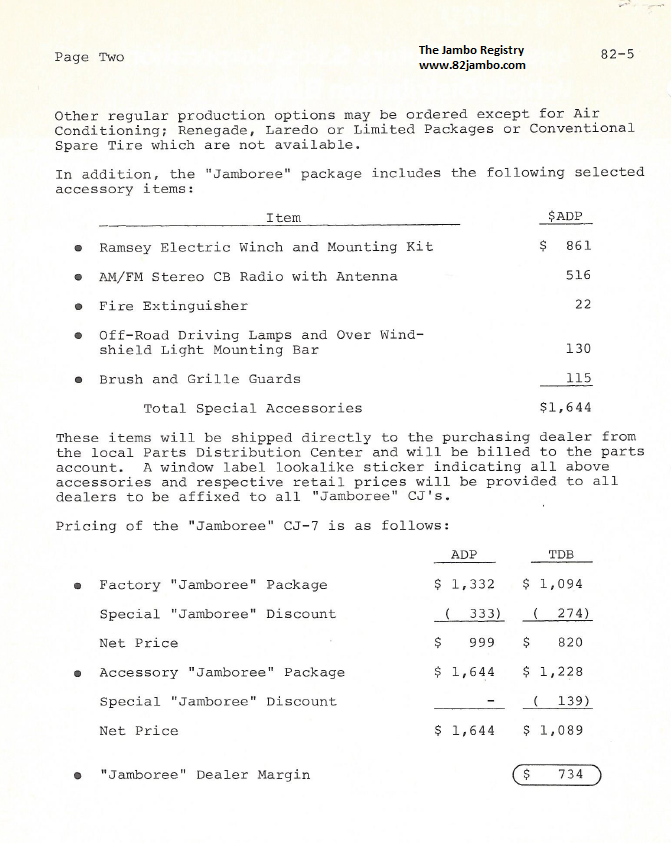 |
Page Two: The top of this page informs dealers that
AC is not available on the Jambo. Who needs AC? Jambos are for men! As
we discuss below, Jeep would later reverse this decision. We also see the price of the Jamboree accessories. $115 ($310 in today's dollars) for the brush and grille guards! $130 ($351 today) for the Jambo light bar with lights--Not bad. The Ramsey winch and mounting kit would have set you back $861 in 1982. That is about $2,300 in today's dollars. And, the CB was $516 ($1,390 today). What is interesting is that letter states that Jeep sent a window sticker that listed the accessory items. We would love to find one of those! Dealers made $734 ($1,981 today) on the accessories. We estimate that fewer than 5% of Jambos (about 30) came with the accessory package. |
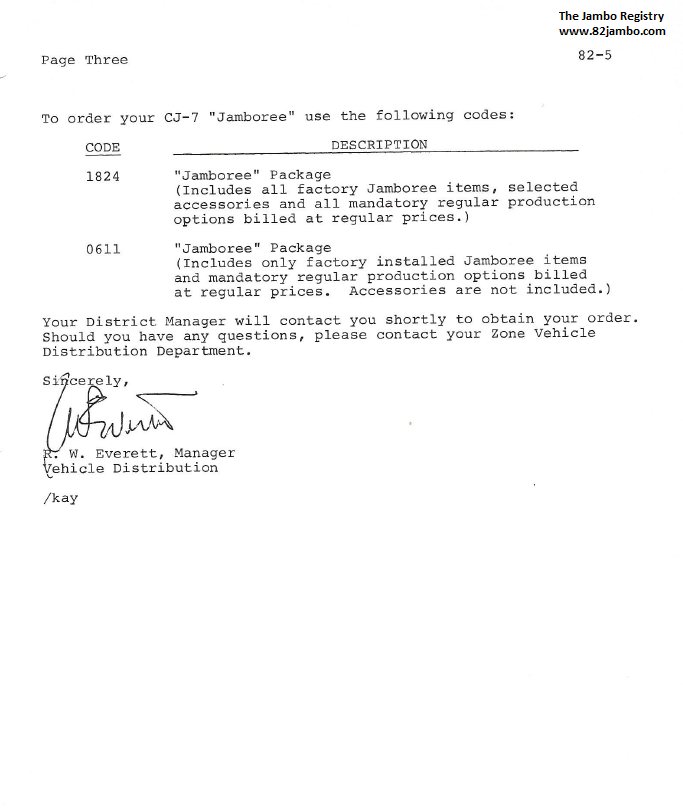 |
Page Three: Dealers could order Jambos without or without the accessories and there were codes for each. |
On February 16, 1982, Jeep sent the letter below to dealers, announcing that a pricing change and that AC was available on JAMBOREE models.
 |
Revision:
Jeep decided to allow air conditioning. This change must have been the
result of complaints from dealers. The only reason AC was not allowed
was the AC was an under-dash unit. This required relocating the ashtry
to the dash, right where the Jambo badge goes. With this change, Jeep
would have needed to either delete the ashtray or relocate it to
another location. We don't know what they did, as we have not seen a
Jambo with factory AC. This decision to allow AC was announced on February 16, 1982, which was a Tuesday. This letter would then have to be mailed to dealers. Therefore, they likely did not know of this change until the last week of February. Jambo production began the first week of March and those Jambos were batch built. So, we do not believe AC was included in the first group of Jambos (the G group), which included Jambos #0031 - #0442 (maybe #0450). However, we could be wrong about this. |
The Jambo required some regular production options, such as 258 ci engine, T-5 transmission, etc. It also required the Factory Jamboree Package, which included the paint, seats, carpeting, roll bar pad and saddle bags, chrome wheels, spare tire cover, and Jamboree badge. In addition, you could purchase the Accessory Jamboree Package, which included the Ramsey winch, AM/FM CB, fire extinguisher, light bar, and brush/grille guards. The table below details the cost of each item in 1982 dollars (the actual cost at the time) and in 2018 dollars, assuming an inflation rate of 2.8%. This is the average rate of inflation between 1982 and 2018, based on the Consumer Price Index.
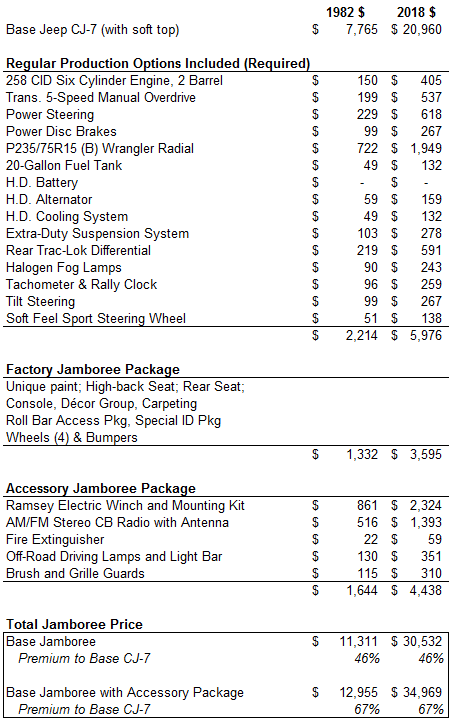
A base Jamboree cost $3,546 more than a base CJ-7. That cost included the required regular production options ($2,214) and the Factory Jamboree Package ($1,332). Together, this was a 46% premium to the base CJ-7. In 2018 dollars, a base Jamboree cost $30,532.
A Jamboree that included the Accessory Jamboree Package, cost an additional $1,644. This brought the total to $12,955, which was $5,190 more than a base CJ-7--a 67% premium. In 2018 dollars, a fully equipped Jamboree cost nearly $35,000. This is a par with what a JK Rubicon costs today.
This is a Jeep marketing photo of Jambo #2000. It appears in the Jambo brochure. We do not believe this was actually #2000. The brochure is dated 3-82 and this picture was probably taken during the initial run of Jambos, which were produced between February and March 1982. So, this Jambo was mostly like numbered below #0450, but a #2000 plaque was installed for pictures.
Notice that it is equipped as detailed above. This Jambo also includes the following dealer-installed options: Ramsey Model 2001 Electric Winch and with Roller Guide Mounting Kit (not the Warn winch), Over Windshield Light Mounting Bar with Off-Road Driving Lights (Marchal 859s), Brush Guard (relocating factory-installed Marchal 850 fog lights), and a Grille Guard. As shown in the Jambo sales brochure, this Jambo also included the AM/FM/CB and dual radio speakers.

Notice the color of this Jambo is a bit different than the one shown on the brochure. We believe this is just because of the poor quality print sent to The Jambo Registry by Chrysler.
The dash of #2000 is below. Notice the Rally Clock to the left of the steering wheel, as in the Laredo. The AM/FM/CB is clearly visible, as is the mounting location of the CB mic. If you look very closely you can see the top of the ash tray (painted black), just to the left of the gear shift. Also, notice the steering wheel and the grab bar. The Jambo came with the soft-feel steering wheel, not the leather-wrapped Laredo steering wheel. In addition, the grab bar is just a basic grab bar, not the Laredo leather-wrapped one.

Here is the flyer provided to dealers that lists the Jambo equipment:

Notice that this only lists Topaz Gold Metallic as the color option. As detailed above, all Jambos were supposed to be Topaz Gold Metallic, but a decision to add white was made about two-thirds of the way through the production run.
1982 was a year of change at Jeep. The most significant changes were:
(1) The loss of the 304 V8 (it could be specially ordered in 1981)
(2) The introduction of wide-track axles; 1982-1986 CJ-7s have a noticeably wider-stance than prior CJ-7s (CJ-5s never received the wide-track axles).
(3) The introduction of the six-digit odometer. This makes is much easier to confirm the mileage of Jambos, as compared to earlier Jeeps such as the Silver Anniversary or the Super Jeep.
(4) The new BorgWarner T-5 manual transmission was introduced. The wide-ratio TorqueFlite 999 automatic transmission, used in 1982, first appeared in 1980.
(5) The introduction of an optional 20-gal optional fuel tank, which was standard on the Jambo.
(6) Finally, Jeep planned to use movable window vents (wind wings) on hard doors and a redesigned dash pad with thin ends. However, this change did not appear until very late in the 1982 model year (about 85% of the way through production). You can read more about that here.
The Jambo is a mixture of a Renegade and a Laredo, with many more options than either Jeep had. Below is a listing of features the Jambo took from each model. Essentially, the Jambo was sporty, or off-road, Laredo. It keeps the sporty features of the Renegade, but added better tires (radials), better suspension, a tach/clock, matching seats, and carpet. It took the functional elements of a Laredo that would be helpful off-road, without some of the chrome extras. To this, Jeep added many special options (see Jamboree column).
| Renegade | Laredo | Jamboree |
| Included in
Jamboree Package Soft-feel 3-spoke Sports Steering Wheel (brushed stainless steel spokes; black) Instrument Panel Overlay Frame Cover Black Rocker Panel Moldings Items Not Included in Jamboree Package Exterior Striping L78 x 15B Tracker Tires Underhood Light Spare Wheel Lock (we are not certain about this, but don't think it was included; you would not want a spare wheel lock out on the Rubicon trail) |
Included in
Jamboree Package Cara Grain Vinyl High-Back Bucket Seats Matching Rear Bench Seat Indoor/outdoor carpeting (black) Chrome Front Bumper Chrome Rear Bumperettes Chrome 15x7 Wheels Chome Hub Covers P235/75R15 Wrangler Radials Console w/o Trim Pad Tachometer & Clock Heavy Duty Shocks Gray Tone Tinted Quarter Windows on Hard Top Items Not Included in Jamboree Package Exterior Striping Chrome Mirrors Leather Wrapped Steering Wheel Leather Wrapped Grab Bar Pin Striping on Dash Overlay Padded Console |
Standard
Features Not Included in Other Packages Jamboree Decal Lettering Jamboree Spare Tire cover Gold Purse Straps (replacing silver straps used in Laredo) Special Serialized Jambo Dash Plaque (denoting production number) Topaz Gold Metallic Paint (Olympic White was included later) Options Available in Other Packages that were Standard in the Jamboree Package 258 6-cylindar 5-speed Manual Transmission Power Steering Power Breaks 20-gal Fuel Tank Heavy Duty Battery Heavy Duty Alternator Heavy Duty Cooling Heavy Duty Suspension Trac-Loc Rear Axle Black Soft Top Tilt Steering Wheel Marchal 850 Halogen Fog Lamps Roll Bar Pad & Saddle Bags Dealer-Installed Options Ramsey 2001 8000-lb Electric Winch AM/FM/CB Radio and Antenna Light Bar Marchal 859 Driving Lights Brush Guard & Grille Guard Fire Extinguiser Items Not Included in Jamboree Package Air Conditioning Factory-Installed Radio Conventional Spare Tire |
Here is a flyer put together by the Jeep Parts division! Special thanks to the Jeepers Jamboree for sharing this and to Heath Aggen (#0180) for cleaning the image up! According to this flyer, Jambos could be ordered with the "Jamboree" Package, which included all the dealer installed accessories (Ramsey winch, AM/FM CB with Antenna, Fire Extinguisher, Marchal 859s on light bar, and the brush and grille guards--the Marchal 850s on the bumper were included in the base model). The retail price of the "Jamboree" package was $1,644 (equivalent to about $4,000 today). Dealers made $734 on this sale.

Interestingly, the 1983 accessories catalog features a Topaz Gold Metallic CJ-7 on the front without the Jambo lettering. This catalog came out in July 1982, which after Jambo production ended in June 1982 and the end of the 1982 model year. The basis for this catalog must have been a picture of Jambo #2000 without the Jamboree lettering.
Here is a picture of that "Jambo". Notice the Jambo seats and Jambo optional equipment. The only non-Jambo items are the running boards, the passenger-side mirror, and the chrome grille overlay. This Jambo is missing the very cool Marchal stone guards for the Marchal 850 fog lights (on bumper) and the Marchal 859 driving lights (on light bar).

For more detail on Jambo parts and equipment, please click here.
Below are two pictures of a Jambo in the Toledo factory in 1982. These pictures are screen shots taken from an internal film that was made for a meeting of AMC suppliers, which was held March 30, 1982. So, this film was likely shot in early March 1982. This is when the G-1 and G-2 Jambos were produced. This film was uncovered by a group that is preparing a documentary about AMC. You can follow the group on Facebook.
On film, the narrotor explains that this Jambo has been moved to a "Quality Review Center." This space was open to all employees to check the quality of all Jeeps. This particular Jambo had a problem with the seal around its windshield. These pictures are important! We can see that Jambos were glossy. The rocker moldings are black. There is only a single (driver's side) side mirror. The Marchal fog lights are present and the kitty is black.
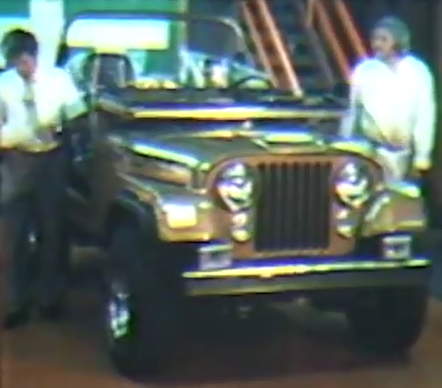 |
 |
Here is a picture of the box that contained the film.

Here is a link to the film. It is fun to watch. Make sure to watch the sceen that shows how they painted Jeeps in 1982 (this process was new in 1982) and the scene with the Jambo.
|
© Copyright 2018. J. Eric Bickel. All rights reserved The Jambo Registry is a trademark of www.82jambo.com. UA-83787031-1 |